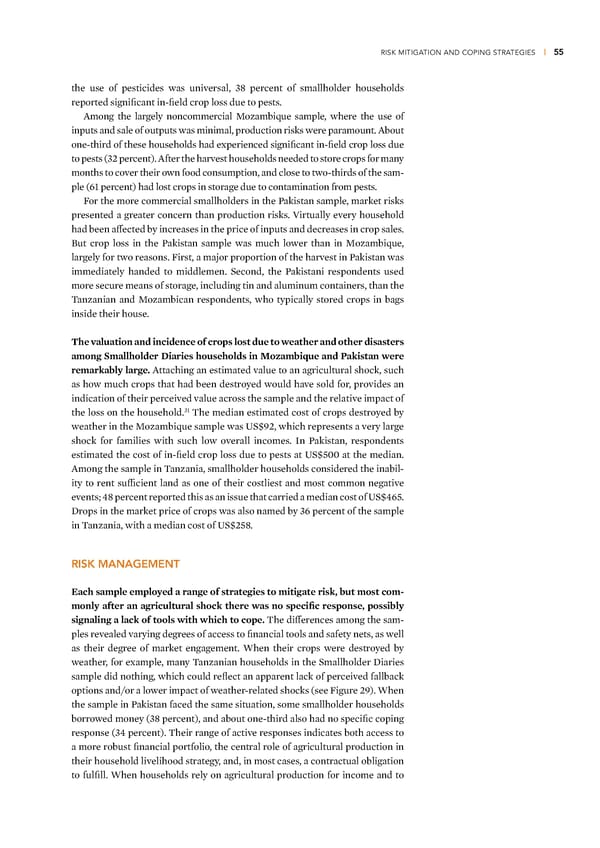RISK MITIGATION AND COPING STRATEGIES | 55 the use of pesticides was universal, Ÿ¡ percent of smallholder households reported significant in-field crop loss due to pests ˆmong the largely noncommercial –o—ambiue sample, where the use of inputs and sale of outputs was minimal, production riss were paramount ˆbout one-third of these households had experienced significant in-field crop loss due to pests (Ÿ‘ percent) ˆfter the harvest households needed to store crops for many months to cover their own food consumption, and close to two-thirds of the sam- ple (¢… percent) had lost crops in storage due to contamination from pests or the more commercial smallholders in the aistan sample, maret riss presented a greater concern than production riss §irtually every household had been affected by increases in the price of inputs and decreases in crop sales £ut crop loss in the aistan sample was much lower than in –o—ambiue, largely for two reasons irst, a ma„or proportion of the harvest in aistan was immediately handed to middlemen Second, the aistani respondents used more secure means of storage, including tin and aluminum containers, than the Œan—anian and –o—ambican respondents, who typically stored crops in bags inside their house he aluation and incidence of crops lost due to weather and other disasters among Smallholder Diaries households in oambi ue and ‚aƒistan were remarƒably large ˆttaching an estimated value to an agricultural shoc, such as how much crops that had been destroyed would have sold for, provides an indication of their perceived value across the sample and the relative impact of Ÿ… the loss on the household Œhe median estimated cost of crops destroyed by weather in the –o—ambiue sample was ©S±ž‘, which represents a very large shoc for families with such low overall incomes €n aistan, respondents estimated the cost of in-field crop loss due to pests at ©S±”’’ at the median ˆmong the sample in Œan—ania, smallholder households considered the inabil- ity to rent sufficient land as one of their costliest and most common negative events “¡ percent reported this as an issue that carried a median cost of ©S±“¢” ‰rops in the maret price of crops was also named by Ÿ¢ percent of the sample in Œan—ania, with a median cost of ©S±‘”¡ RISK MANAGEMENT †ach sample employed a range of strategies to mitigate risƒ, but most com- monly after an agricultural shocƒ there was no specific response, possibly signaling a lacƒ of tools with which to cope Œhe differences among the sam- ples revealed varying degrees of access to financial tools and safety nets, as well as their degree of maret engagement ™hen their crops were destroyed by weather, for example, many Œan—anian households in the Smallholder ‰iaries sample did nothing, which could reflect an apparent lac of perceived fallbac options and¤or a lower impact of weather-related shocs (see igure ‘ž) ™hen the sample in aistan faced the same situation, some smallholder households borrowed money (Ÿ¡ percent), and about one-third also had no specific coping response (Ÿ“ percent) Œheir range of active responses indicates both access to a more robust financial portfolio, the central role of agricultural production in their household livelihood strategy, and, in most cases, a contractual obligation to fulfill ™hen households rely on agricultural production for income and to
 Financial Diaries with Smallholder Families Page 70 Page 72
Financial Diaries with Smallholder Families Page 70 Page 72